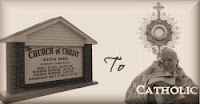 We move now from God's dwelling place, the tabernacle, to a vessel called a monstrance in which the Eucharist is exposed to us, visible and vulnerable so that we may adore Him. The word monstrance itself comes from the Latin monstrare, which means "to show." It's typically a beautiful and ornate vessel, with a transparent center so that the host which is placed in it can be seen by and shown to those present.
We move now from God's dwelling place, the tabernacle, to a vessel called a monstrance in which the Eucharist is exposed to us, visible and vulnerable so that we may adore Him. The word monstrance itself comes from the Latin monstrare, which means "to show." It's typically a beautiful and ornate vessel, with a transparent center so that the host which is placed in it can be seen by and shown to those present.The monstrance is used for several occasions. One is adoration, where the Blessed Sacrament is exposed in the monstrance, and left on the altar so that people can come and pray or simply be in Christ's presence, and adore him. A famous story from the Curé d'Ars, St. Jean Vianney, relates the tale of a peasant who would spend hours apparently doing nothing but sitting quietly in church. When asked what he was doing, he responded, "I look at Him, and He looks at me." This is what many do in adoration. Some pray. Some read scripture or devotionals. Some even sing...recently at adoration, it was calmly quiet as usual, when a lone lady began singing hymns to Our Lord. It was touching, hearing one lone voice echoing in the cathedral in hymns of adoration.
 I have a special place in my heart for adoration, as my very first time in a Catholic Church was in the middle of the night during adoration. I wasn't yet 100% convinced of the truth of Catholicism...and before attending my first mass, I took an opportunity to simply check out the church from the inside first. Many parishes will have perpetual adoration, and when this is the case people sign up for typically around hour long slots, so that the exposed Christ is never left alone, even in the dark of the night. There was one or two other people there praying, but what I remember most was a beautiful and surprisingly tangible sense of calm and peace (and this in a quite turbulent time of my life.) This was my first encounter with Christ in the Eucharist, and I look back on it fondly!
I have a special place in my heart for adoration, as my very first time in a Catholic Church was in the middle of the night during adoration. I wasn't yet 100% convinced of the truth of Catholicism...and before attending my first mass, I took an opportunity to simply check out the church from the inside first. Many parishes will have perpetual adoration, and when this is the case people sign up for typically around hour long slots, so that the exposed Christ is never left alone, even in the dark of the night. There was one or two other people there praying, but what I remember most was a beautiful and surprisingly tangible sense of calm and peace (and this in a quite turbulent time of my life.) This was my first encounter with Christ in the Eucharist, and I look back on it fondly!Benediction is when the priest takes the Eucharist in the monstrance and blesses the people with it. When he does this, he wears a shawl-like vestment called a humeral veil, to cover his hands when picking up the monstrance so that he doesn't touch it. This is to symbolize the fact that this blessing is not from him, but from Christ present in the Eucharist.
 Another use of the monstrance is in a Eucharistic Procession. This is especially common on the feast of Corpus Christi (the Body of Christ.) Once again, the monstrance is held by the priest using the humeral veil, and it is processed outside under a rectangular canopy called a baldachin (which can be seen in the two pieces of artwork which portray a procession). It's quite a powerful way to bring Christ to those in the street.
Another use of the monstrance is in a Eucharistic Procession. This is especially common on the feast of Corpus Christi (the Body of Christ.) Once again, the monstrance is held by the priest using the humeral veil, and it is processed outside under a rectangular canopy called a baldachin (which can be seen in the two pieces of artwork which portray a procession). It's quite a powerful way to bring Christ to those in the street.
The following video is one that was made to promote and encourage vocations, but it shows a Eucharistic procession in the streets of New York. The juxtaposition of the modern streets in the background with this long held tradition is really very beautiful.
"In thy presence there is fullness of joy" (Ps 16:11)
"Be still, and know that I am God." (Ps 46:10)
"Can you not watch one hour with me?" (Matt 26:40)
"And all the angels stood round about the throne, and about the ancients, and about the living creatures; and they fell on their faces, and adored God, saying: ‘Amen. Blessing and glory and wisdom and thanksgiving, honor and power and strength to our God forever and ever. Amen’" (Rev 7:11-12).
Come, let us adore Him, indeed!



1 comment:
I love your blog! Your knowledge and faith is amazing and I look forward to each entry!
Thank you!
~Jaime Chase
www.ChaseNKids.com
Post a Comment